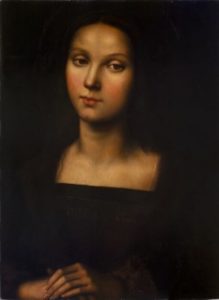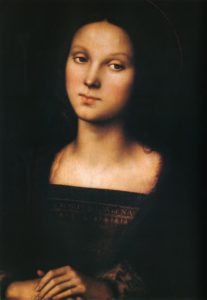It seems like everyone’s claiming they have an original Raphael these days. With the ongoing debates over the De Brécy Tondo coming back into the news recently, another group of researchers claimed that a Mary Magdalene portrait currently in a private collection is likely an original by the Renaissance master. However, others are incredibly skeptical.
The Mary Magdalene portrait was dated around 1504 and is likely an oil-on-panel copy of another painting created by Pietro Perugino, of whom Raphael Sanzio was a student. The original picture by Perugino has been kept at the Palatine Galleries of the Pitti Palace in Florence since 1641. The figure is said to be based on Perugino’s wife, Chiara Fancelli, who modeled for her husband in several other works. Researchers presented their findings at a conference in Pergola, Italy, concluding that the Magdalene portrait in question is by Raphael after discovering various substances underneath the paint. They found a fine dust that they identified as pounce, also known as spolvero in Italian, which artists had used in transferring their designs. Irving Stone’s biographical novel on Michelangelo, The Agony and the Ecstasy, described this process in great detail. In this process, an artist sketches their design on a piece of paper, then creates a series of small holes overtop the lines, making what is known as a cartoon. The artist then places the cartoon against a surface, whether a panel, a canvas, or a wall, and then dabs the holes with a pouch filled with ground charcoal or chalk, transferring the outline from the cartoon to the surface of their final work. The artist now has a rough design of their subject upon which to apply paint and other media. According to the researchers, Perugino did not use this method, but Raphael certainly did.
While some are hopeful about this news, others have their doubts. The most vocal skeptic has been the undersecretary of Italy’s Ministry of Culture, art critic Vittorio Sgarbi. I vaguely remembered his name from last May, when he commented on a portrait some were attributing to Titian: “If that’s a Titian, I’m Napoleon!” Sgarbi took to Twitter, again employing his sharp tongue: “Raphael? Impossible: at best, it’s a prototype by Pietro Perugino. It’s impossible that the painting announced in Pergola is by the master from Urbino.”
Furthermore, many have corrected the research team on one of their claims, pointing out that Perugino did, in fact, use spolvero in some of his works. Most notably, he used the technique in creating his frescoes at the Collegio del Cambio in Perugia. Other critics have also taken notice of the portrait’s alleged date. The original Perugino portrait was created around 1500, while the research team dates the supposed Raphael copy to 1504. Raphael experts claim that if this dating is correct, that means the copy is unlikely by Raphael. By 1504, Raphael was already an artist in his own right, not an apprentice anymore. Therefore, it would be confusing why he would create a copy of his teacher’s work when he had already left Perugino’s workshop. The work must pre-date the Perugino portrait to be a genuine Raphael. This would be equally as confusing since why would the master go out of his way to copy the work of one of his pupils? A master may draw inspiration from their students’ work, but they rarely overtly copy. Some have also pointed out that one of the research team members, Annalisa di Maria, has been known to make inaccurate and rather premature attributions in the past.
More research must be done on the alleged Raphael to reach a more accurate conclusion on its authorship. The new research results will be published in an upcoming edition of the journal Art and Science, operated by Open Science.


